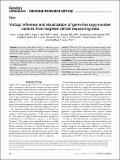VisCap: inference and visualization of germ-line copy-number variants from targeted clinical sequencing data

View/
Author
Pugh, Trevor J.
Bowser, Mark J.
Gowrisankar, Sivakumar
Hynes, Elizabeth
Mahanta, Lisa M.
Published Version
https://doi.org/10.1038/gim.2015.156Metadata
Show full item recordCitation
Pugh, Trevor J., Sami S. Amr, Mark J. Bowser, Sivakumar Gowrisankar, Elizabeth Hynes, Lisa M. Mahanta, Heidi L. Rehm, Birgit Funke, and Matthew S. Lebo. 2016. “VisCap: inference and visualization of germ-line copy-number variants from targeted clinical sequencing data.” Genetics in Medicine 18 (7): 712-719. doi:10.1038/gim.2015.156. http://dx.doi.org/10.1038/gim.2015.156.Abstract
Purpose: To develop and validate VisCap, a software program targeted to clinical laboratories for inference and visualization of germ-line copy-number variants (CNVs) from targeted next-generation sequencing data. Genet Med 18 7, 712–719. Methods: VisCap calculates the fraction of overall sequence coverage assigned to genomic intervals and computes log2 ratios of these values to the median of reference samples profiled using the same test configuration. Candidate CNVs are called when log2 ratios exceed user-defined thresholds. Genet Med 18 7, 712–719. Results: We optimized VisCap using 14 cases with known CNVs, followed by prospective analysis of 1,104 cases referred for diagnostic DNA sequencing. To verify calls in the prospective cohort, we used droplet digital polymerase chain reaction (PCR) to confirm 10/27 candidate CNVs and 72/72 copy-neutral genomic regions scored by VisCap. We also used a genome-wide bead array to confirm the absence of CNV calls across panels applied to 10 cases. To improve specificity, we instituted a visual scoring system that enabled experienced reviewers to differentiate true-positive from false-positive calls with minimal impact on laboratory workflow. Genet Med 18 7, 712–719. Conclusions: VisCap is a sensitive method for inferring CNVs from targeted sequence data from targeted gene panels. Visual scoring of data underlying CNV calls is a critical step to reduce false-positive calls for follow-up testing. Genet Med 18 7, 712–719.Other Sources
http://www.ncbi.nlm.nih.gov/pmc/articles/PMC4940431/pdf/Terms of Use
This article is made available under the terms and conditions applicable to Other Posted Material, as set forth at http://nrs.harvard.edu/urn-3:HUL.InstRepos:dash.current.terms-of-use#LAACitable link to this page
http://nrs.harvard.edu/urn-3:HUL.InstRepos:27822202
Collections
- HMS Scholarly Articles [17922]
Contact administrator regarding this item (to report mistakes or request changes)


